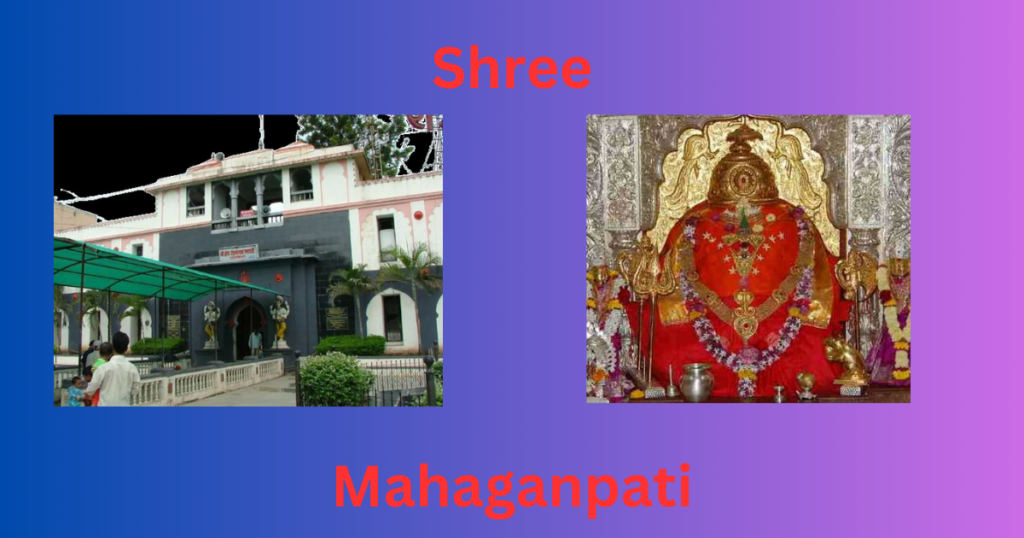
The Sacred Oasis of Ranjangaon
Nestled amidst the enchanting landscapes of Pune, Maharashtra, the temple of Mahaganpati in Ranjangaon stands as a symbol of devotion and divine grace. This revered shrine is the fourth among the Ashtavinayak temples, dedicated to Lord Ganesha, the beloved Remover of Obstacles. The story that unfolds within these hallowed walls is one of celestial intervention and the ultimate triumph of good over evil.
The Divine Abode of Ranjangaon
Ranjangaon, enveloped in the spiritual aura of Lord Shiva’s presence, serves as the backdrop for this captivating narrative. As legends go, it was Lord Shiva himself who chose this serene region to install the divine murti of Lord Ganesha. Little did anyone know that this sacred ground would soon witness a grand confrontation between the forces of righteousness and the malevolent demon, Tripurasura.
Tripurasura’s Reign of Chaos
Tripurasura, endowed with a formidable boon from Lord Ganesha, had become an unstoppable force of destruction. His invincibility extended to all, except Lord Shiva. With newfound strength and boundless arrogance, he stormed the heavens, overthrowing the gods and usurping the throne of Lord Indra. His dark intentions now turned toward Lord Shiva’s sacred realm, Kailasa.
The Terror Unleashed by Bhimkay and Vajradanta
Earth, too, bore the brunt of Tripurasura’s malevolence. He dispatched two fearsome rakshasas, Bhimkay and Vajradanta, to sow terror and chaos. The world quaked under their tyranny, forcing the gods themselves to seek refuge in the sheltering embrace of the Himalayas.
Lord Shiva’s Cunning Disguise
Desperate to avert a catastrophe, Lord Shiva resorted to clever disguise. Assuming the guise of a Brahman, he approached the menacing Tripurasura. The Brahman proclaimed that he possessed 64 wondrous creations, a claim that piqued the demon’s curiosity. Tripurasura made a tempting offer – if he found the creations pleasing, he would grant the Brahman any boon he desired.
The Divine Gift and Ominous Warning
In response to Tripurasura’s request, the Brahman conjured three magnificent airplanes, allowing the demon to traverse the skies. However, he accompanied this gift with a grave warning – these very airplanes would become the instruments of his downfall at the hands of Lord Shiva’s archery.
The Unintended Act of Sealing Fate
Overjoyed with his newfound treasures, Tripurasura magnanimously offered ten villages to the Brahman as a token of gratitude. Unbeknownst to him, this benevolent act would ultimately seal his fate in the impending cosmic battle.
The Cosmic Battle and Divine Victory
A titanic clash of cosmic forces ensued between Lord Shiva and Tripurasura, a battle that would determine the fate of the universe. With righteousness and divine purpose on his side, Lord Shiva invoked the potent “Pranyamamshirsha devam” mantra. In a single awe-inspiring archery, he vanquished the malevolent demon, putting an end to the reign of terror
The Commemoration of Triumph
This monumental victory transpired on the auspicious day of Karthik Shudha Pournima, now known as Tripuri Pournima, in honor of the triumph. The very place where Lord Shiva chanted Lord Ganesha’s mantra, “Pranyamam Shirsha Devam,” became renowned as Ranjangaon. This sacred spot would serve as the foundation for the temple of Mahaganpati.
A Legacy of Devotion and Blessings
In acknowledgment of this historic victory and the enduring presence of Lord Ganesha at Ranjangaon, the esteemed Peshwas bestowed upon devout devotees the ancestral right to worship Mahaganpati. To this day, pilgrims and devotees journey from distant corners of the land to seek the divine blessings of Mahaganpati, the fourth Ashtavinayak, and immerse themselves in the vibrant tapestry of this enduring legend.
Shree Ashtavinayak Ganpati 5 : Shree Varadavinayak
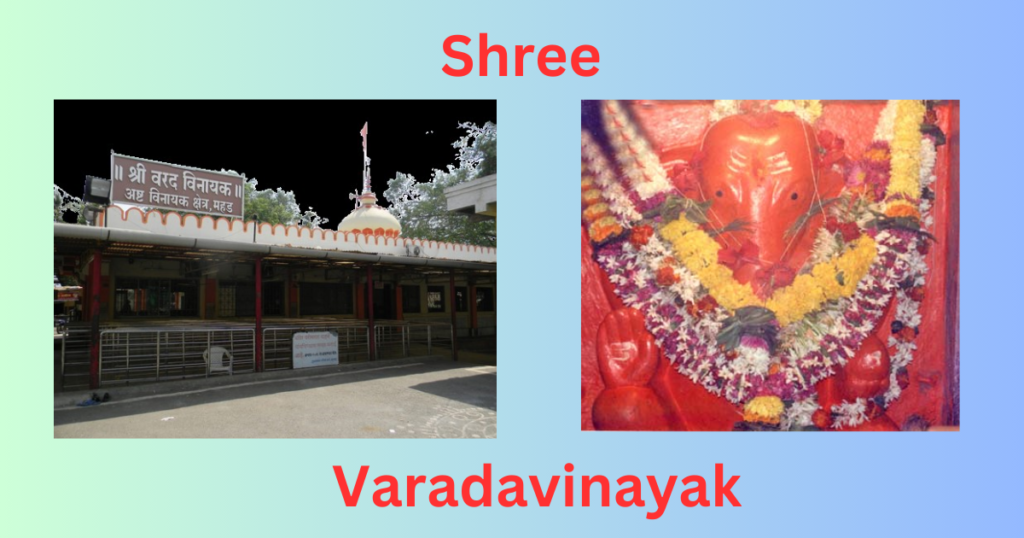
The Desperate Quest for an Heir
In the heart of the ancient kingdom of Koudinyapur, there ruled a king named Bhima and his queen. Their reign was marked by prosperity, but a shadow loomed over their happiness—they were childless. Desperate to secure their lineage and provide an heir to the throne, they embarked on a journey into the mystical forest, seeking solace and divine intervention.
Sage Vishwamitra’s Divine Gift
In the depths of the forest, the royal couple encountered the venerable sage Vishwamitra. Known for his asceticism and profound wisdom, Vishwamitra recognized their longing for a child. With boundless compassion, he bestowed upon King Bhima a powerful mantra, the Ekashar Gajana Mantra, a sacred incantation known for its ability to grant the fervent wishes of its chanters. The couple embraced the mantra with unwavering devotion, and the heavens responded to their plea with the birth of a son, Prince Rukmaganda, who would become their cherished heir.
Rukmaganda’s Enchanting Youth
Prince Rukmaganda, raised in the loving embrace of his parents, blossomed into a handsome and virtuous young man. His innate qualities and striking appearance endeared him to all who crossed his path. His future as a noble ruler seemed assured, but fate had more intriguing twists to reveal.
The Fateful Encounter with Rishi Vachaknavi
During a hunting expedition, Prince Rukmaganda’s journey led him to the serene hermitage of Rishi Vachaknavi, a sage revered for his austere life and devotion. However, it was not the sage but his wife, Mukunda, who would play a pivotal role in the unfolding drama. Mukunda, captivated by the prince’s charm and beauty, found herself irresistibly drawn to him. In a bold move, she beseeched Rukmaganda to fulfill her desires.
Virtue Confronts Temptation
Despite his undeniable allure, Prince Rukmaganda remained unwavering in his virtue and moral principles. In the face of Mukunda’s passionate advances, he sternly rejected her advances, adhering to the code of righteousness. With a heavy heart, he left the ashram, leaving behind a lovesick Mukunda, who was unable to shake her unrequited feelings.
A Divine Deception
Mukunda’s overwhelming desire and unfulfilled longing reached the ears of none other than King Indra, the ruler of the heavens. In a crafty disguise, King Indra assumed the form of Rukmaganda and engaged in an intimate union with Mukunda. Unbeknownst to her, this liaison resulted in pregnancy, and she gave birth to a son named Gritsamada, who would play a pivotal role in the unfolding drama.
Curses That Shape Destinies
As Gritsamada grew, he discovered the perplexing truth surrounding his birth—a truth that filled him with anger and bitterness. In a fit of rage, he cursed his own mother, Mukunda, condemning her to transform into the unattractive and thorny berry-bearing “Bhor” plant. Mukunda, in turn, retaliated by cursing her own son, foretelling the birth of a cruel rakshasa from his lineage. In their haste, they remained unaware of the heavenly revelation that was about to change everything.
The Heavenly Revelation
Suddenly, a celestial voice echoed from the heavens, proclaiming, “Gritsamada is the son of Indra.” This revelation left both mother and son stunned, realizing that their curses were too late to be revoked. Mukunda was transformed into the Bhor plant, and Gritsamada, overcome with shame and regret, sought refuge in the sacred Pushpak forest, where he would embark on a journey of redemption and penance.
Lord Ganesha’s Divine Boon
In the depths of the Pushpak forest, Gritsamada turned to Lord Ganesh (Ganapati), the benevolent remover of obstacles. Impressed by his unwavering penance, Lord Ganesha appeared before him and offered a divine boon. Gritsamada’s heart swelled with gratitude as he was granted a son who would be invincible in battle, save for one exception—Lord Shiva (Shankara).
The Birth of Varadavinayaka
Overwhelmed with joy and a sense of purpose, Gritsamada beseeched Lord Ganesha to bless the very forest where he had found solace. He implored Ganesha to permanently reside there, granting knowledge of Brahma and bestowing blessings upon devotees who sought solace in the forest. In homage to this sacred encounter, Gritsamada erected a temple, and the idol of Lord Ganesha within came to be known as Varadavinayaka. The once-ordinary forest was now transformed into Bhadraka, a testament to the transformative power of faith and devotion.
The Power of Prasad during Maghi Chaturthi
The Varadavinayaka temple, steeped in divine history, draws pilgrims from far and wide, especially during Maghi Chaturthi. It is said that those who partake of the coconut received as prasad during this auspicious occasion will be blessed with the cherished gift of a son. Thus, during Maghi Utsav, the temple brims with devoted souls seeking not only divine blessings but also the fulfillment of their deepest desires—a poignant reminder of the enduring power of faith and the enchanting legend of Varadavinayaka.
Shree Ashtavinayak Ganpati 6 : Shree Chintamani
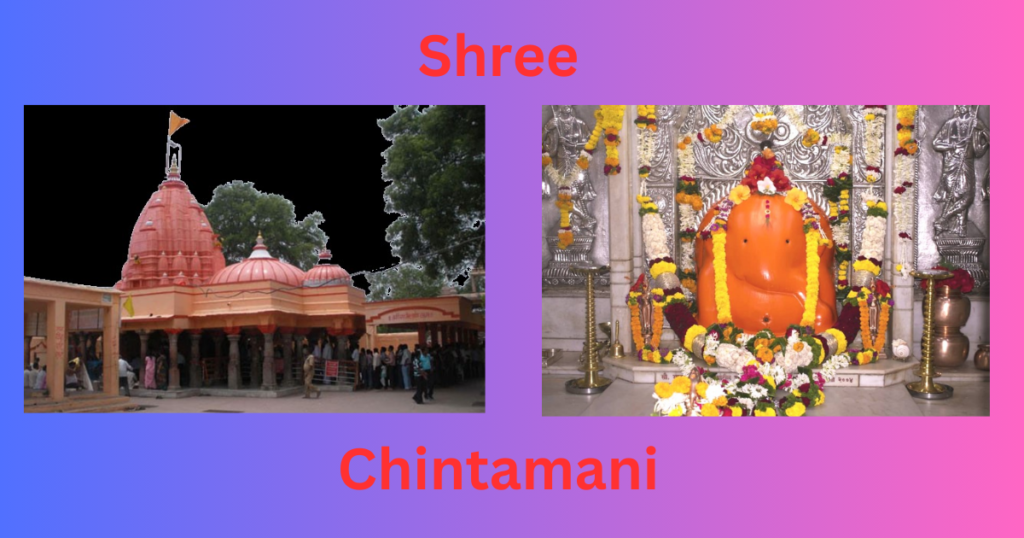
Shree Ashtavinayak Ganpati is a renowned pilgrimage circuit in the state of Maharashtra, India, comprising eight temples dedicated to Lord Ganesha. These temples hold immense religious significance and are visited by devotees seeking blessings and the removal of obstacles in their lives. Among these temples, Shree Chintamani Temple, the sixth in the Ashtavinayak pilgrimage, is particularly revered for its historical importance and the unique legend associated with it.
Location and History:
Shree Chintamani Temple is situated in the tranquil village of Theur, which is located in the Haveli Taluka of Pune district, Maharashtra. This ancient temple has a rich history dating back many centuries. It stands as a symbol of the region’s deep-rooted spiritual heritage.
Significance:
Shree Chintamani Temple holds a special place in the hearts of devotees who visit the Ashtavinayak circuit. It is considered the sixth temple in the pilgrimage and is a sacred place for those seeking relief from worries and anxieties, as Lord Ganesha is believed to be the dispeller of all troubles. The temple’s peaceful ambiance and spiritual vibrations make it a popular destination for pilgrims.
Architecture and Structure:
The architecture of Shree Chintamani Temple is a beautiful blend of traditional Marathi temple design. The main sanctum, housing the idol of Lord Ganesha, is a stone structure adorned with intricate carvings and decorations. The idol itself is made of black stone and is depicted with its trunk turned to the left. The temple complex includes a spacious courtyard and well-maintained gardens, creating a serene atmosphere for devotees.
Legend:
The Tale of Gana and the Coveted Chintamani Jewel
Gana, despite his hot-headed nature, was a devout worshiper of Lord Shiva, Ganesha’s father. His intense devotion to the god of destruction caught Shiva’s attention and favor. In recognition of Gana’s unwavering reverence, Shiva decided to grant him a remarkable boon—a kingship that would span the three worlds: heaven, earth, and the underworld. But there was a condition; Gana could not be killed by anything that possessed any of the three gunas, the fundamental qualities that define all aspects of existence.
The Arrival at Sage Kapila’s Hermitage
Gana, despite his hot-headed nature, was a devout worshiper of Lord Shiva, Ganesha’s father. His intense devotion to the god of destruction caught Shiva’s attention and favor. In recognition of Gana’s unwavering reverence, Shiva decided to grant him a remarkable boon—a kingship that would span the three worlds: heaven, earth, and the underworld. But there was a condition; Gana could not be killed by anything that possessed any of the three gunas, the fundamental qualities that define all aspects of existence.
The Arrival at Sage Kapila’s Hermitage
One day, Gana, accompanied by his entire army, arrived at the hermitage of Sage Kapila. Kapila, a revered sage known for his possession of the wish-granting jewel called Chintamani, welcomed the prince and his army with hospitality. The sage, using the mystical powers of the Chintamani, conjured a lavish feast for his guests, leaving them in awe of his abilities.
The Avaricious Desire for Chintamani
One day, Gana, accompanied by his entire army, arrived at the hermitage of Sage Kapila. Kapila, a revered sage known for his possession of the wish-granting jewel called Chintamani, welcomed the prince and his army with hospitality. The sage, using the mystical powers of the Chintamani, conjured a lavish feast for his guests, leaving them in awe of his abilities.
The Avaricious Desire for Chintamani
Despite the sage’s generosity, the greedy heart of Prince Gana was not content. His eyes fixated on the Chintamani jewel, and a burning desire to possess it consumed him. He approached Sage Kapila, expressing his fervent wish to obtain the jewel for himself. However, the sage, aware of Gana’s impure intentions, refused the prince’s request, emphasizing the jewel’s divine significance.
The Sinister Seizure of Chintamani
Blinded by his avarice, Gana was not willing to accept Kapila’s refusal. Ignoring the sage’s pleas and warnings, Gana forcibly seized the Chintamani jewel from Kapila’s possession, an act that would set in motion a chain of divine events.
Kapila’s Prayer to Lord Ganesha
Sage Kapila, a devout devotee of Lord Ganesha, found himself bereft of the precious Chintamani jewel that had graced his hermitage for so long. In his moment of despair, Kapila turned to Lord Ganesha for help. He fervently prayed for the return of the stolen jewel, seeking Ganesha’s divine intervention.
Ganesha’s Divine Intervention
Responding to Kapila’s plea, Lord Ganesha, along with his divine army, manifested in Prince Gana’s dream. In this ethereal encounter, one of Ganesha’s powerful soldiers swiftly beheaded Gana, a symbolic act of divine justice.
The Vengeful March to Kapila’s Hermitage
Awakened from his dream and driven by vengeance, Gana assembled his army and marched relentlessly toward Sage Kapila’s hermitage. His intent was clear: to slay the sage and reclaim the Chintamani jewel. Even the pleas of his father, King Abhijit, could not deter Gana from his malevolent mission.
Ganesha’s Shakti and the Thousand-Armed Warrior
As Gana’s army descended upon Kapila’s hermitage, a divine manifestation occurred. Ganesha’s shakti, the goddess Siddhi, summoned a formidable warrior named Laksha. Possessing a thousand arms, Laksha unleashed a devastating onslaught upon Gana’s army, decimating it with ease.
The Divine Beheading by Lord Ganesha
With his army in ruins and his arrogance shattered, Prince Gana confronted Lord Ganesha himself. In this climactic moment, Ganesha, in his divine form, beheaded the arrogant prince, putting an end to his reign of greed and destruction.
The Return of Chintamani and Ganesha’s Eternal Presence
Following the decisive battle, Lord Ganesha, true to his benevolent nature, returned the Chintamani jewel to Sage Kapila. However, the sage, overwhelmed by his devotion to Ganesha, chose the divine presence of the Lord over the material possession of the jewel itself. Thus, Ganesha decided to remain in Theur, taking on the name Chintamani, a living symbol of the sage’s unwavering faith.
In the present day, the legend of Chintamani Ganesha at Theur continues to captivate devotees, serving as a testament to the enduring power of faith, divine intervention, and the consequences of arrogance and greed.
Festivals and Celebrations:
Shree Chintamani Temple comes alive during important Hindu festivals, with Ganesh Chaturthi being the most significant. Devotees from far and wide gather to celebrate this festival with great fervor, performing various rituals and offering special prayers to Lord Ganesha. The idol is adorned with elaborate decorations, and the temple resonates with devotional songs and chants during this time.
Pilgrimage Experience:
Visiting Shree Chintamani Temple is a spiritually enriching experience. Devotees come here not only to seek blessings and solutions to their problems but also to find inner peace and tranquility. The serene surroundings and the presence of the divine idol create a powerful and calming atmosphere for introspection and devotion.
In conclusion, Shree Chintamani Temple is a sacred destination within the Ashtavinayak pilgrimage circuit, known for its historical significance and the legend of the Chintamani gem. This temple embodies the belief in Lord Ganesha as the alleviator of worries and fulfiller of desires, making it a cherished place of worship for countless devotees in Maharashtra and beyond.
Shree Ashtavinayak Ganpati 7 : Shree Girijatmaj
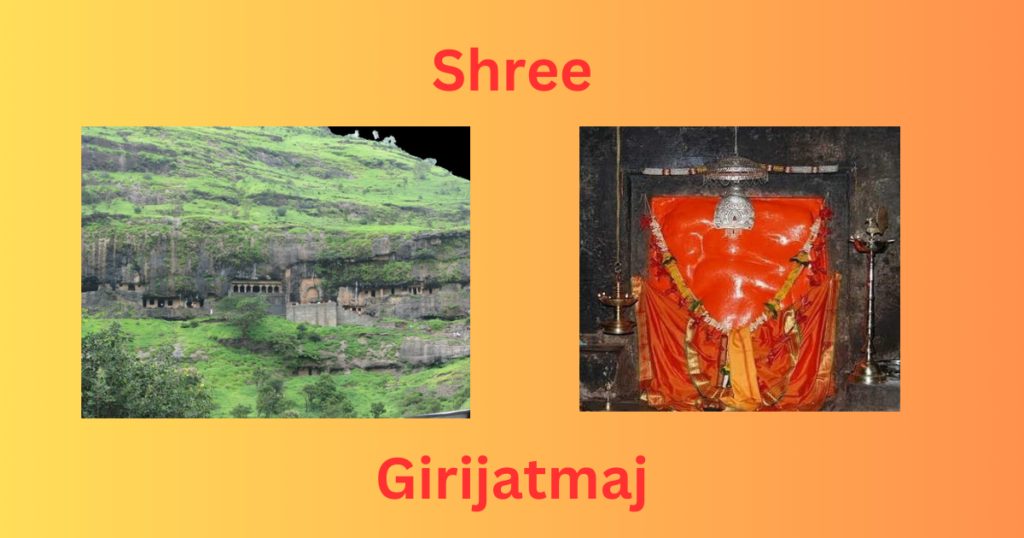
Girijatmaj Ganpati: The Enigmatic Lord of the Mountains
In the heart of the Sahyadri mountain range in Maharashtra, amidst the rugged terrain and lush greenery, lies the sacred temple of Girijatmaj Ganpati. One of the revered Ashtavinayak temples, Girijatmaj Ganpati, holds a unique place in the hearts of devotees. This article unravels the mystical tale of this extraordinary deity and the legend that surrounds him.
Legend
The Birth of Mayuresvara – Ganesha Incarnate
According to the Ganapatya scripture known as the Ganesha Purana, there exists a divine incarnation of Lord Ganesha named Mayuresvara, also referred to as Mayureshwar. This unique manifestation of Ganesha possessed six arms and adorned a white complexion. His chosen mount was none other than the resplendent peacock. The purpose of Mayureshwar’s earthly presence was to confront and vanquish the formidable demon Sindhu.
Parvati’s Devotion and Austerities
The story unfolds with Parvati, often lovingly addressed as Girija, expressing her curiosity to Lord Shiva. She inquired about the object of his meditation, to which Lord Shiva revealed that he was immersed in deep contemplation of Ganesha, the “supporter of the entire universe.” He initiated Parvati into the mystical realm of the Ganesha Mantra, the sacred syllable “Gam.” However, Parvati’s heart yearned for more; she desired to have a son.
Parvati’s Prolonged Meditation
Driven by her maternal longing, Parvati embarked on a profound spiritual journey. For twelve years, she underwent rigorous austerities, meditating unwaveringly upon Ganesha. Her chosen abode for these spiritual practices was the sacred site of Lenyadri, where the divine would soon grace her with his presence.
Ganesha’s Divine Blessing
Pleased by Parvati’s unwavering penance and devotion, Ganesha bestowed upon her the divine boon she had ardently sought. He promised to be born as her son, fulfilling her maternal dreams. This divine revelation brought immense joy to Parvati’s heart.
The Birth of Ganesha at Lenyadri
As the sacred lunar calendar marked the fourth day of the bright fortnight in the Hindu month of Bhadrapada, known as Ganesh Chaturthi, Parvati embarked on a ritual to worship a clay image of Ganesha. To her astonishment and delight, the clay image miraculously came to life, marking the divine birth of Ganesha at Lenyadri.
The Bestowal of Name and Boon by Shiva
After his birth, Ganesha was named Gunesha by Lord Shiva. Shiva further granted him a remarkable boon—that anyone who invoked Ganesha’s name before commencing a task would find success in their endeavors. This divine decree bestowed the power of Ganesha’s blessings upon all who sought his guidance.
Gunesha’s Formative Years
For the initial fifteen years of his earthly existence, Gunesha grew and thrived at Lenyadri. However, lurking in the shadows was Sindhu, the demon who harbored the knowledge that his ultimate demise would be at the hands of Gunesha.
The Demon’s Failed Attempts
In a bid to eliminate the young Ganesha, Sindhu unleashed a legion of formidable demons, including Krur, Balasur, Vyomasur, Kshemma, Kushal, and others. Yet, every attempt to vanquish Ganesha proved futile, as he not only emerged unscathed but also defeated his adversaries.
Ganesha’s Divine Armaments
At the tender age of six, Ganesha received homage from Vishwakarma, the divine architect-god. In recognition of his divine nature, Ganesha was endowed with powerful weapons, including the Pasha (noose), Parashu (axe), Ankusha (hook), and Padma (Lotus). These divine armaments further fortified his divine essence.
The Emergence of Mayuresvara
In one enchanting episode of his childhood, Ganesha playfully knocked an egg from a mango tree, giving birth to a magnificent peacock. In response to this miraculous event, Ganesha assumed the name Mayuresvara and mounted the newly created peacock.
The Triumph over Sindhu
The grand climax of this divine narrative unfolds at Morgaon, where Mayuresvara, now astride the peacock, confronted the formidable demon Sindhu. In a fierce battle, Mayuresvara emerged victorious, defeating Sindhu and his army-generals, marking the pivotal moment at the renowned Ashtavinayaka temple.
This enchanting legend of Mayureshwar, the embodiment of Lord Ganesha, serves as a testament to the power of devotion, maternal love, and the divine’s unwavering protection over his devotees.
The Unique Temple Cave
The temple of Girijatmaj Ganpati is not an ordinary one; it is situated within a natural cave carved into the rocky Lenyadri hills. Devotees embark on a pilgrimage to reach the temple, climbing over 300 stone steps that wind through the picturesque hills. The journey is not just a spiritual one; it offers breathtaking panoramic views of the Sahyadri mountain range.
The Divine Idol
As you step into the cave temple, you are greeted by the enchanting idol of Girijatmaj Ganpati. The deity is depicted as a child with a distinctively serene expression, symbolizing the divine bond between a mother and her son. The idol is adorned with precious jewels and intricate carvings, reflecting the rich heritage of Indian craftsmanship.
Devotees’ Pilgrimage
Devotees from all walks of life make the arduous journey to seek the blessings of Girijatmaj Ganpati. They believe that the deity grants them the strength to overcome obstacles and fulfill their wishes. The temple comes alive with vibrant festivities during the auspicious occasion of Ganesh Chaturthi when thousands gather to celebrate and seek the divine blessings.
Conclusion
The story of Girijatmaj Ganpati is not just a tale of myth and legend; it is a testament to unwavering faith and devotion. The temple’s unique location within the Lenyadri hills and the divine presence of the deity make it a significant pilgrimage site for Hindus. Girijatmaj Ganpati continues to inspire countless devotees, offering solace, strength, and the promise of overcoming life’s challenges.
As you stand atop the Lenyadri hills, gazing at the enchanting idol of Girijatmaj Ganpati, you can’t help but marvel at the mystical aura that surrounds this sacred place. It is a reminder that faith can move mountains, and devotion knows no bounds.
In your quest for spiritual solace and the blessings of Lord Ganesha, the journey to Girijatmaj Ganpati is a pilgrimage that will etch memories and devotion into your heart forever.
Shree Ashtavinayak Ganpati 8 : Shree Vighneshwar
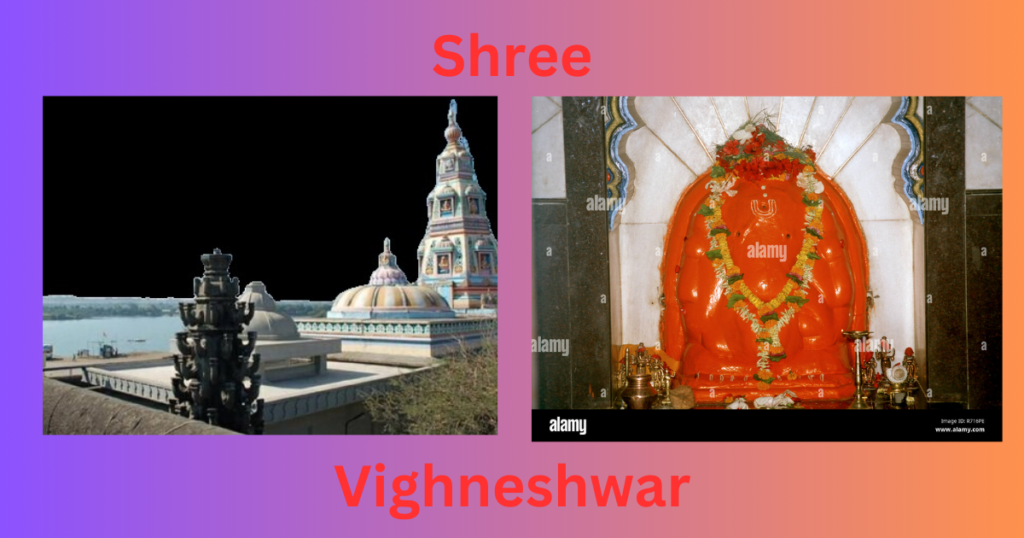
Vighneshwar Ganpati: The Remover of Obstacles
Nestled in the quaint town of Ozar, Maharashtra, amidst the tranquil ambiance of the Sahyadri mountain range, lies the sacred temple of Vighneshwar Ganpati. As one of the revered Ashtavinayak temples, Vighneshwar Ganpati holds a special place in the hearts of devotees. In this narrative, we delve into the mystical tale of this extraordinary deity and the legend that surrounds him.
The Mythical Origins
King Abhinandan’s Ambitious Yagna
In the annals of mythology, the tale of King Abhinandan’s ambitious yagna unfolds, a story steeped in both determination and divine intervention. Abhinandan aspired to attain the exalted status of Trilokadhish, the ruler of the three worlds—Heaven, Earth, and the Netherworld. His pursuit of this lofty goal set the stage for a celestial drama.
Indra’s Concern and Creation of Vighnasura
The relentless determination of King Abhinandan to become Trilokadhish sent ripples of concern through the heavens. The reigning god, Lord Indra, troubled by the impending loss of his throne, devised a plan to thwart Abhinandan’s grand yagna. In his divine workshop, he fashioned a fearsome demon named Vighnasura, endowing him with a single, ominous purpose—to disrupt the king’s yajna and create chaos.
Vighnasura’s Reign of Disruption
Vighnasura, armed with his malevolent mission, took flight to Earth. He not only fulfilled his primary task of disrupting King Abhinandan’s yagna but went a step further by launching a relentless campaign against all yagnas across the land. The sanctity of these sacred rituals was under siege.
The Appeal of the Sages
As Vighnasura’s reign of disruption spread far and wide, the sages and rishis of the land were gripped by despair. The sanctity of their rituals and sacrifices lay in ruins, and they were left with no recourse but to beseech divine intervention.
Ganapati’s Divine Call
In their hour of need, the sages invoked the divine presence of Lord Ganapati, the Remover of Obstacles. Their fervent prayers reached the ears of the benevolent elephant-headed deity. With compassion in his heart, Ganapati answered their call for assistance.
The Confrontation Between Ganapati and Vighnasura
Armed with unwavering devotion and divine purpose, Lord Ganapati confronted Vighnasura, the demon responsible for the mayhem. In a clash that reverberated through the heavens, the two formidable forces faced off. The outcome of this celestial battle would determine the fate of the yagnas and the spiritual well-being of the land.
Vighnasura’s Surrender and Request
In a surprising turn of events, Vighnasura, overwhelmed by the divine presence of Ganapati, chose to surrender. His malevolence gave way to a realization of the error of his ways. Ganapati, in his infinite wisdom and compassion, accepted Vighnasura’s surrender and sought to negotiate a truce.
Vighnasura’s Surrender and Request
Ganapati, having secured Vighnasura’s surrender, laid down certain conditions for his release. The most pivotal among them was that Vighnasura must never disrupt the yagnas performed in Ganapati’s name. This condition would ensure the sanctity and continuity of the sacred rituals.
Ganapati’s Conditions for Mercy
Moved by his transformation and newfound devotion, Vighnasura made a heartfelt request to Ganapati. He implored that before invoking Ganapati’s name, devotees should chant the mantra “Bhaktagananti.” Additionally, he beseeched Ganapati to establish his divine presence in the very place where this momentous encounter had transpired.
Vighnasura’s Pleading Request
Ganapati, ever magnanimous and compassionate, agreed to Vighnasura’s requests. Thus, in accordance with their pact, Ganapati chose to reside in that sacred place under the name of Vighnahara—a name symbolizing his role as the Remover of Obstacles. The spiritual sanctity of the land was restored, and the faith of the devotees remained unwavering.
In this tale of divine intervention and redemption, Lord Ganapati’s benevolence and Vighnasura’s transformation stand as enduring symbols of hope and the power of devotion to bring about positive change.
The Divine Encounter
The legend of Vighneshwar Ganpati is intimately associated with the sage Gritsamad’s story. The sage performed intense penance to seek Lord Ganesha’s blessings. Impressed by Gritsamad’s devotion, Lord Ganesha appeared before him and granted him a divine wish. The sage requested that Lord Ganesha take residence in the serene Ozar, ensuring the well-being and prosperity of its inhabitants. Lord Ganesha, in his benevolence, agreed to the sage’s plea and resided in the Ozar temple.
The Magnificent Temple of Vighneshwar Ganpati
The temple of Vighneshwar Ganpati, an architectural marvel, reflects the grandeur of the Maratha dynasty. The temple’s design incorporates exquisite carvings and intricate sculptures, drawing architecture enthusiasts and devotees alike. The sanctum sanctorum houses the idol of Lord Vighneshwar Ganpati, characterized by his distinctive elephant head and a trunk that gracefully curves to the right.
Devotees’ Pilgrimage
Devotees from across the nation embark on a spiritual pilgrimage to seek the blessings of Vighneshwar Ganpati. They come with hearts burdened by troubles and leave with a sense of inner peace and resolution. The temple resonates with the sound of hymns and the fragrance of incense as devotees offer their prayers and seek the deity’s divine intervention in overcoming life’s challenges.
Festivities at Vighneshwar Ganpati Temple
The auspicious festival of Ganesh Chaturthi is celebrated with great fervor and devotion at the Vighneshwar Ganpati Temple. The temple comes alive with colorful processions, traditional music, and cultural performances. Thousands of devotees gather to witness the grandeur of the celebrations and participate in the aarti (ritual offering of light) to seek Lord Vighneshwar’s blessings.
Conclusion
Vighneshwar Ganpati, the lord who removes obstacles, embodies the essence of faith, devotion, and the triumph of good over evil. The temple in Ozar stands as a testament to the enduring bond between Lord Ganesha and his devotees. It is a place where the troubled find solace, the seeking find answers, and the faithful find strength.
As you stand before the divine idol of Vighneshwar Ganpati, you cannot help but be overwhelmed by a sense of tranquility and hope. It is a reminder that no obstacle is insurmountable with faith and the divine blessings of Lord Ganesha.
In your spiritual journey, the Vighneshwar Ganpati Temple in Ozar beckons, offering not only a respite from the challenges of life but also a profound connection with the remover of obstacles
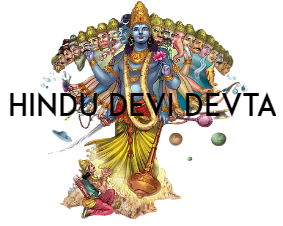
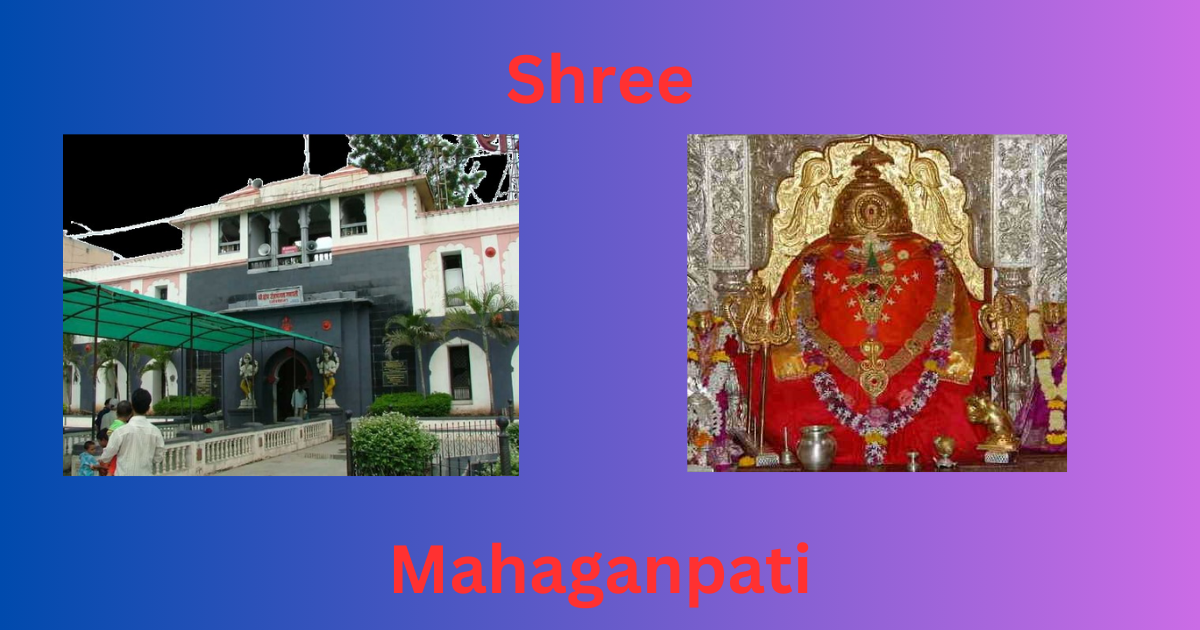
Thank you for your sharing. I am worried that I lack creative ideas. It is your article that makes me full of hope. Thank you. But, I have a question, can you help me?
you can join me on discord, Discord Username: vishal_020387
You can visit my websites,
https://intellectaiworld.com/
https://vishalversatile.com/
https://hindudevidevta.com/